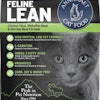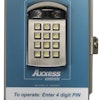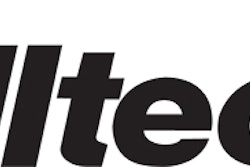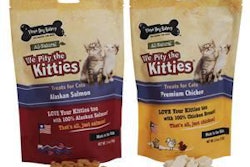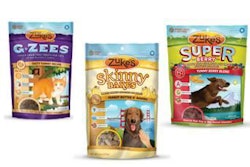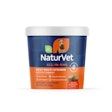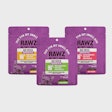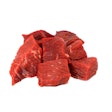Many businesses in the petfood industry today have their roots in other areas of expertise. But whether these companies began in livestock or human nutrition, whether their focus was commercial or industrial, they have one thing in common: petfood was a natural progression that came from realizing their knowledge had practical applications in the world of feeding pets.
Horn has been in business for 52 years, and for this company, establishing itself in animal wellness was a process of realization. "We are a business model that started more on an industrial side," said Lisa Alley-Zarkades, vice president of Horn Animal Wellness. "Our model started out as a technical sales team selling innovation into industries. That expanded past industrial areas and went into more consumer-based areas. That's how we got into the nutraceutical market, we got into the food industry, we got into the personal care industry."
After that came FoodTech, Horn's ingredients division with an emphasis on health and wellness. After FoodTech was established, the realization came that a lot of ingredients could be beneficial to the pet industry, and three years ago Horn went on to create the animal wellness business unit as an extension of FoodTech.
Stratum Nutrition, a Novus International business, also evolved into the petfood industry. "The mainstay of Novus' business since the beginning was livestock nutrition," said Ingmar Middelbos, PhD, manager of specialty products and the pet market at Stratum. "Livestock nutrition and pet (and human) nutrition have a lot of overlap and the initial foray of Novus into the petfood industry was really via a natural extension of the livestock nutrition business." In 2009, Stratum Nutrition was formed within Novus with focus on human nutrition and health. "Because pet nutrition in many ways is more similar to human nutrition than livestock nutrition, the petfood industry focus was aligned under the Stratum Nutrition banner," said Middelbos.
DSM saw an opportunity to expand into the petfood market and took it, purchasing Roche's vitamins and fine chemicals division in 2003. Roche itself goes back to the early 1960s, and has always done a lot of work with the petfood industry, especially in the area of clinical nutritional science for companion animals. Purchasing the vitamins division drew DSM in to that spectrum. "We were one of the earliest vitamin manufacturers ever involved in the nutrition arena for companion animals," said Jeff Alix, global marketing manager of pet nutrition for DSM.
Alltech has been in business for over 30 years with a focus on animal health, and the company began featuring companion animal health topics at its international symposium in the mid-'80s to provide education to the industry. Now, Alltech's symposium has an entire session dedicated to petfood, annually addressing new technologies, breakthrough research and innovative solutions for the industry.
Companies that didn't begin in the petfood market, but instead have grown into it, may have a key advantage over those that focus solely on pets: knowledge. "Because of Novus' expertise in animal nutrition we can not only leverage the collective knowledge, but also the products since many of them apply to pet nutrition as much as to livestock nutrition," said Middelbos. "From the other side, the expertise Stratum has on specialty health ingredients is of vital importance because there is a strong drive for health ingredients to cross from the human space into petfood and pet supplements. So, internally we get to pick the best of both worlds and this helps us tremendously in providing our petfood industry customers with ever more progressive solutions to their challenges. Having the broad view of the food and nutrition industry as a whole also helps us identify emerging technologies and trends and develop those (where possible) for the petfood industry."
Behind this wealth of knowledge are people, and diversity leads to teamwork and an expanded problem-solving ability that might be more difficult to come by in a single-industry company. "We've hired people who have been in the industry and have expertise, and they want to be able to take that expertise and actually create something," said Alley-Zarkades. "So there's a very entrepreneurial spirit in each business unit."
Roger Clemens, DrPH, CFS, chief scientific officer at Horn, agreed. "I think if you look at the composition of the team here, each of the experiences represented by the team members represents a diversity needed to put things together," he said. "Most companies just don't have it."
That diversity of expertise then leads to perhaps an equally important advantage, according to Alix. "I think what it does is it builds a loyalty factor into our relationships," he said. "We tend to speak the same language. We know our businesses very well, we've been entrenched in this industry for a very long time, so we're respected in the industry as an ingredients manufacturer, and we have those types of relationships."
Branching out into the petfood industry isn't an isolated event for a company, and even after being established, cooperation among the various departments continues to ensure the maintenance of those advantages. "There are many overlaps between pet and livestock and pet and human," said Middelbos. "If you just look at what petfood is, on paper it is closer to animal feed, but in reality it is much closer to human food. People want to feed their pets the way they feed themselves, which elevates the desired ingredients and quality of petfoods to human standards. In addition, pets tend to have the same health challenges as humans do (e.g., obesity, joint problems, digestive health challenges, etc.), which to a large degree links back solutions for humans to petfood; we're trying to apply the solutions for humans to pets. Likewise, there are many nutrition and health solutions that are applied in petfood today that were pioneered in livestock nutrition. With pet nutrition sitting in the middle, we get the view from both sides and sometimes this even leads to combining technologies from both sides to make a better technology."
According to Juan Gomez-Basauri, PhD, global director of companion animal business at Alltech, human food, petfood, animal feed and agriculture are all links in the same chain. "From 'farm to fork' or 'farm to bowl', knowledge and information from one link can make a big difference in another," said Gomez-Basauri. "It can help shorten product development cycle; it can outline trends for new product development. Social responsibility, fair trade, traceability and sustainability are no longer trends. In order to provide safe, sound nutrition and health to people and animals, we need to widen our view of the industry and take into account what the ultimate consumer wants."
In fact, the ideas of teamwork and acknowledging that chain become standard, and inform the basis for how the companies work with their clients. "You can look at this in several dimensions," said Alix of DSM's strategy. "One is more from a commercial side, of being able to provide the raw materials themselves in a way that can be utilized for the petfood industry. Then on existing nutritional science, we do a lot of analytical support for the petfood industry—if they're running studies … we try to stay connected with those companies and have our materials used in their processes to learn with them. And for new nutritional science, where we do a lot of collaborations to try to make some headway, try to expand on nutritional science, to bring new nutrients to the marketplace."
In the end, "partnership" becomes the keyword that makes everything work. "We're an extension of the suppliers' sales team," said Alley-Zarkades of Horn's school of thought. "It allows us to do the work that they can't get to—it's very complementary."
Gomez-Basauri also describes Alltech's business model as one of partnership. "Our model is being a solutions provider," he said. "We are beyond the buyer/vendor model. We work in a very close relationship with our business partners, [including] R&D, product development and marketing teams. We forge research alliances where a specific solution is needed, or where imminent breakthroughs are coming from our research pipeline."
The result is a business model primed for success. "It's a partnership at its best," said Alix. "We seek a partnership with our customers, because we realize that in order to be a leader in this marketplace, you have to be more than just a supplier of all-over-the-wall products—if it's all over the wall, it's all about price, and everything else becomes secondary. And so we approach our customers on a partnership level."


